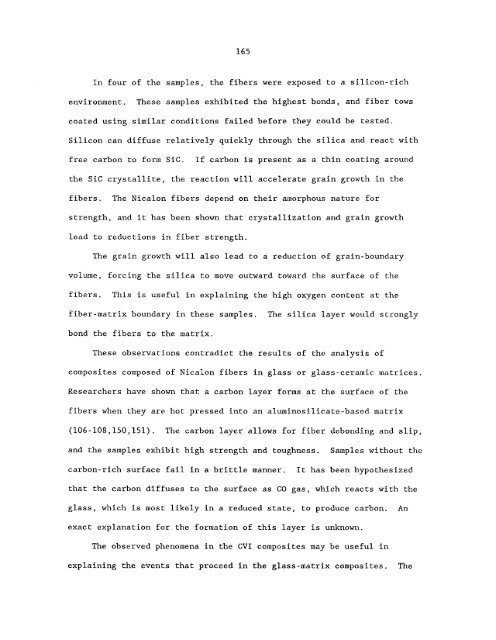Characterization and control of the fiber-matrix interface in ceramic ...
Characterization and control of the fiber-matrix interface in ceramic ...
Characterization and control of the fiber-matrix interface in ceramic ...
You also want an ePaper? Increase the reach of your titles
YUMPU automatically turns print PDFs into web optimized ePapers that Google loves.
165<br />
In four <strong>of</strong> <strong>the</strong> samples, <strong>the</strong> <strong>fiber</strong>s were exposed to a silicon-rich<br />
environment. These samples exhibited <strong>the</strong> highest bonds, <strong>and</strong> <strong>fiber</strong> tows<br />
coated us<strong>in</strong>g similar conditions failed before <strong>the</strong>y could be tested.<br />
Silicon can diffuse relatively quickly through <strong>the</strong> silica <strong>and</strong> react with<br />
free carbon to form Sic. If carbon is present as a th<strong>in</strong> coat<strong>in</strong>g around<br />
<strong>the</strong> Sic crystallite, <strong>the</strong> reaction will accelerate gra<strong>in</strong> growth <strong>in</strong> <strong>the</strong><br />
<strong>fiber</strong>s. The Nicalon <strong>fiber</strong>s depend on <strong>the</strong>ir amorphous nature for<br />
strength, <strong>and</strong> it has been shown that crystallization <strong>and</strong> gra<strong>in</strong> growth<br />
lead to reductions <strong>in</strong> <strong>fiber</strong> strength.<br />
The gra<strong>in</strong> growth will also lead to a reduction <strong>of</strong> gra<strong>in</strong>-boundary<br />
volume, forc<strong>in</strong>g <strong>the</strong> silica to move outward toward <strong>the</strong> surface <strong>of</strong> <strong>the</strong><br />
<strong>fiber</strong>s. This is useful <strong>in</strong> expla<strong>in</strong><strong>in</strong>g <strong>the</strong> high oxygen content a% <strong>the</strong><br />
<strong>fiber</strong>-<strong>matrix</strong> boundary <strong>in</strong> <strong>the</strong>se samples.<br />
The silica layer would strongly<br />
bond <strong>the</strong> <strong>fiber</strong>s to <strong>the</strong> <strong>matrix</strong>.<br />
These observations contradict <strong>the</strong> results <strong>of</strong> <strong>the</strong> analysis <strong>of</strong><br />
composites composed <strong>of</strong> Nicalon <strong>fiber</strong>s <strong>in</strong> glass or glass-<strong>ceramic</strong> matrices.<br />
Kesearchers have shown that a carbon layer forms at <strong>the</strong> surface <strong>of</strong> <strong>the</strong><br />
<strong>fiber</strong>s when <strong>the</strong>y are hot pressed <strong>in</strong>to an alum<strong>in</strong>osilicate-based <strong>matrix</strong><br />
(106-108,150,151). The carbon layer allows for <strong>fiber</strong> debond<strong>in</strong>g <strong>and</strong> slip,<br />
<strong>and</strong> <strong>the</strong> samples exhibit high strength <strong>and</strong> toughness. Samples without <strong>the</strong><br />
carbon-rich surface fail <strong>in</strong> a brittle manner.<br />
It has been hypo<strong>the</strong>sized<br />
that <strong>the</strong> carbon diffuses to <strong>the</strong> surface as CO gas, which reacts with <strong>the</strong><br />
glass, which is most likely <strong>in</strong> a reduced state, to produce carbon. An<br />
exact explanation for <strong>the</strong> formation <strong>of</strong> this layer is unknown.<br />
The observed phenomena <strong>in</strong> <strong>the</strong> CVI composites may be useful <strong>in</strong><br />
expla<strong>in</strong><strong>in</strong>g <strong>the</strong> events that proceed <strong>in</strong> <strong>the</strong> glass-<strong>matrix</strong> composites. The

















